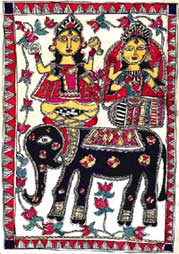Traditional expertise
 The people of Mithila acquired the expertise of extracting colours from plants through trial and error, spanning an experience of over hundred of years. Leaves of bel (Aegle marmelos), bhang (Cannabis sativa), lalpatia (Euphorbia pulcherrima), neel (Indigofera tinctoria), sem (Labalab purpureus) and mehndi (Lawsonia inermis) are crushed on stones to extract the colours. The same process is used to obtain colours from the petals of kataiya (Argemone mexicana), aparajita (Clitoria ternatea), suryamukhi (Helianthus annus), tyora (Impatiens balsamina), anjha (Mirabilis jalapa) and genda (Tagetes erecta), and the bracts of bougainvilleas (Bougainvillea spectabilis).
The people of Mithila acquired the expertise of extracting colours from plants through trial and error, spanning an experience of over hundred of years. Leaves of bel (Aegle marmelos), bhang (Cannabis sativa), lalpatia (Euphorbia pulcherrima), neel (Indigofera tinctoria), sem (Labalab purpureus) and mehndi (Lawsonia inermis) are crushed on stones to extract the colours. The same process is used to obtain colours from the petals of kataiya (Argemone mexicana), aparajita (Clitoria ternatea), suryamukhi (Helianthus annus), tyora (Impatiens balsamina), anjha (Mirabilis jalapa) and genda (Tagetes erecta), and the bracts of bougainvilleas (Bougainvillea spectabilis).
Hard plant parts are normally boiled in hot water with additives like gum to obtain colours. This applies to roots and fruits of sikkat (Kirganellia reticulata), roots and barks of katahar (Artocarpus heterophyllus), barks of kachnmar (Bauhinia varigata), barks and inner fruit shell of darim (Punica granatum), and heartwood of khair (Acacia catechu) and raktchandan (Pterocarpus santalinus). Dried flowers of palas (Butea monosperma) yield colour after they are soaked in hot water for one or two days. The same process is followed in the case of harsingar (Nyctanthes arbor-tristis) flowers. The corolla tubes yield colour by soaking overnight. Arhul (Hibiscus rosa sinensis) flowers yield lighter shades of black colour on boiling with a few drops of lemon. Root peels of chukandar (Beta vulgaris) and gajar (Daucus carota) yield their colours after thorough crushing. Seeds of poro (Basella rubra) and sita sindur (Bixa orellana) yield instant colours on rubbing between the palms or by crushing with stones. Seeds of sarson (Brassica campestris) and rhizome of haldi (Curcuma domestica) also need crushing to make the aqueous extract.
The aqueous paste of finely powdered raw rice (Oryza sativa) known as pithar is locally used as white colour. Black colour is obtained from seeds of til (Sesamum indicum) and marua (Eleusine coracana). Black colour is also obtained from the soot on cooking earthen vessel. Mixing cow dung with roasted barley seeds produces deep black colour. Barks of babul (Acacia nilotica) and latam (Psidium guajava) are boiled together to get maroon colour. Poro (Basella rubra) seeds are boiled in gum along with flowers of kusum (Carthamus tinctorius) to obtain deep pink colour. Aqueous seed extract of sarson (Brassica campestris) is mixed with sindur (vermilion) to get red shade. Latex of bargad (Ficus bengalensis) and peepal (Ficus religiosa) is mixed with lime to get yellow colour.
Some plant extracts are utilised as additives and fixers providing durability and permanence to the colours. Gum obtained from babul (Acacia nilotica), bel (Aegle marmelos) and neem (Melia azadirachta) are extensively used. The green extract from the leaves of sem (Labalab purpureus) is mixed with mucilaginous extract obtained from soaking the seeds of tisi (Linum usitatissimum) to make it more lasting.
ANIMAL COLOURS
Some colours used in Mithila paintings are of animal origin. Molluscs and lac insects are used to obtain violet and red colours respectively. The deep white secretions from molluscs turn violet. 'Gogli' is a colour preparation obtained by feeding a cow on only mango leaves for 2
Related Content
- The role of rail in decarbonizing transport in Developing Countries
- Climate of the middle: understanding climate change as a common challenge
- 2019 State of the Mountains Report
- Judgement of the Supreme Court of India regarding the question of granting registration to practice medicines to the ‘Paramparya Vaidyas’ of Kerala, 13/04/2018
- Climate‐informed decisions: the capital investment plan as a mechanism for lowering carbon emissions
- India’s strategic role in Globalization moving beyond Cost & Scale; Increasingly focused on Value: Zinnov
